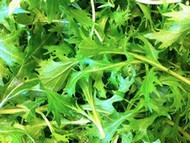How to Grow Mizuna
Mizuna is one of those strange oriental vegetables which arrived in the West in the last 20 years or so. The name for this leafy green comes from the Japanese mizu, for “water,” and nu, for “mustard plant.” Mizuna greens are decorative, adaptable, very vigorous and cold tolerant and have a very long growing season.
Mizuna can be grown to use either as mature plants or as a seedling crop. The first cut of seedlings can sometimes be made two or three weeks after sowing. Where mature plants are grown, forming clumps about 22cm (9") high, keep cutting regularly to produce a continuous crop of small young leaves. Nutritionally mizuna is an excellent source of antioxidants, folic acid, and vitamins A and C.
We find Mizuna to be an extemely reliable and very prolific salad crop. It looks rather like Rocket with a much milder taste and bolt resistant. Fantastic salad filler.
Where to Grow Mizuna
Open position - tolerates shade in summer. Best in fertile free-draining soil - but tolerates just about anything!
Some risk of bolting in very hot dry conditions - less so with early sowings.
When to Grow Mizuna
Sow in-situ or in trays or modules year-round.
Transplanting
From trays or modules harden off and plant out under fleece. Make a hole with a dibber or suitable stick (A piece of an old broom handle is ideal). Place the seedling plug in the hole and firm gently around the roots, water well.
Crop care
Keep well watered but otherwise fairly trouble free.
Pests and diseases
Flea beetle - lays eggs in soil near susceptible plants - eats small holes in stems and leaves.
Beware! - damage is more severe in dry weather - so keep plants well watered. Grow under fleece or nets - if necessary. Unlikely to be problematic in Ireland.
Harvesting
Can be harvested within 3 weeks of sowing - large plants will take 6-8 weeks.
Ideally eat immediately. Store in fridge for a few days only.
As a salad green mizuna can be steamed, boiled, stir-fried or used to complement other greens mixed together for a salad, especially Red Asian Mustard greens. When cooked it shrinks to about half its size so it takes a large amount to make a cooked vegetable dish containing only mizuna.
